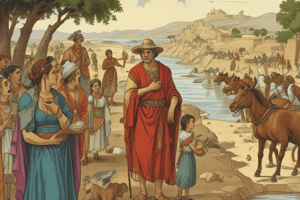Podcast
Questions and Answers
Which of the following best describes the biocultural approach in anthropology?
Which of the following best describes the biocultural approach in anthropology?
- Prioritizing environmental determinism as the primary driver of human behavior.
- The study of human populations based solely on their genetic makeup.
- An approach that examines the interplay between biology, culture, and the environment in shaping human populations. (correct)
- Focusing exclusively on cultural practices, disregarding biological factors.
According to the material, what is a key focus of anthropology regarding human populations?
According to the material, what is a key focus of anthropology regarding human populations?
- Variation and diversity, both biological and cultural. (correct)
- Understanding the origins of life.
- Reducing human populations to a single measurable standard.
- Eliminating diversity to establish universal cultural norms.
Which factor does not directly influence biological variation in human populations, as outlined in the material?
Which factor does not directly influence biological variation in human populations, as outlined in the material?
- Astrological influences. (correct)
- Genetic inheritance.
- Adaptation to environmental forces.
- Technological advancements (culture).
Cultural variation is primarily a result of what?
Cultural variation is primarily a result of what?
Which of the following is not mentioned as being influenced by culture?
Which of the following is not mentioned as being influenced by culture?
According to the material, what is considered one of humankind's greatest adaptive strategies?
According to the material, what is considered one of humankind's greatest adaptive strategies?
The major evolutionary forces shape biological variation. Which option lists only evolutionary forces?
The major evolutionary forces shape biological variation. Which option lists only evolutionary forces?
What type of email should students use for course correspondence?
What type of email should students use for course correspondence?
Which subfield of anthropology focuses primarily on the reconstruction of past cultures through the analysis of material remains?
Which subfield of anthropology focuses primarily on the reconstruction of past cultures through the analysis of material remains?
What is a primary distinction between prehistoric archaeology and historical archaeology?
What is a primary distinction between prehistoric archaeology and historical archaeology?
Which of the following best describes the methodology of an ethnologist?
Which of the following best describes the methodology of an ethnologist?
What is the primary focus of zooarchaeology?
What is the primary focus of zooarchaeology?
Which subfield of biological anthropology is most directly concerned with the study of human evolution and our relationship with other primates?
Which subfield of biological anthropology is most directly concerned with the study of human evolution and our relationship with other primates?
Ethnoarchaeology is best defined as:
Ethnoarchaeology is best defined as:
Which of the following is an example of 'material culture' as it pertains to archaeological studies?
Which of the following is an example of 'material culture' as it pertains to archaeological studies?
What is the primary goal that both ethnologists and archaeologists share, despite their different methodologies?
What is the primary goal that both ethnologists and archaeologists share, despite their different methodologies?
Flashcards
Subfields of Anthropology
Subfields of Anthropology
The four main areas of study in anthropology are Social/Cultural, Linguistic, Physical/Biological, and Archaeology.
Ethnologist
Ethnologist
An ethnologist studies cultures through participant observation and interviews.
Archaeologist
Archaeologist
An archaeologist uncovers material culture to understand past societies through remains.
Material Culture
Material Culture
Signup and view all the flashcards
Prehistoric Archaeology
Prehistoric Archaeology
Signup and view all the flashcards
Ethnoarchaeology
Ethnoarchaeology
Signup and view all the flashcards
Primatology
Primatology
Signup and view all the flashcards
Palaeoanthropology
Palaeoanthropology
Signup and view all the flashcards
Anthropology
Anthropology
Signup and view all the flashcards
Holistic Approach
Holistic Approach
Signup and view all the flashcards
Biological Variation
Biological Variation
Signup and view all the flashcards
Cultural Variation
Cultural Variation
Signup and view all the flashcards
Major Evolutionary Forces
Major Evolutionary Forces
Signup and view all the flashcards
Gene Flow
Gene Flow
Signup and view all the flashcards
Natural Selection
Natural Selection
Signup and view all the flashcards
Adaptation
Adaptation
Signup and view all the flashcards
Study Notes
Course Information
- Course name: ANTH 1210 Ancient Peoples and Places
- Course description: Focuses on ancient peoples and their history
- Welcome message included
Volunteer Note-Taker Information
- Purpose: Help reduce barriers for peers by providing notes.
- Contribution: Contribute to inclusive learning environment
- Recognition: Receive recognition on the University of Manitoba's Experience Record
- Submission method: Submit notes directly to https://sasclockwork.cc.umanitoba.ca/ClockWork/ in a preferred style (typed or handwritten).
- Time commitment: Takes an extra 15 minutes per week.
Review Items
- Notes from Thursday's class are posted on UM Learn (text only)
- No recordings are available
- The course is introductory covering both the field's vocabulary and theoretical aspects.
- All textbook sections are relevant, including perspectives on gender and current research and issues (use the online link, not the bookstore version).
- University email is for course-related communication.
Introduction to Anthropology & Archaeology
- Core topics include:
- Review of Chapter 1 (What is Anthropology?)
- Archaeological methods and materials
- Site formation processes
- Dating methods (various methods)
What is Anthropology?
-
Broad study of human populations (and related) populations.
-
Holistic/biocultural approach considers biology, culture, and environment.
-
A key idea emphasizes that human biological diversity and environmental conditions interrelate and that culture is a major adaptive strategy.
-
Interactions among biology, behaviour, and environment are interconnected.
- Changes in one aspect can affect other aspects.
-
Overall emphasis on variation or diversity; both biological and cultural, within human populations.
-
Biological variations result from genetics, environmental factors (adaptation), and culture (technology).
- Ultimately shaped by major evolutionary forces: gene flow, random genetic drift, natural selection, and mutation.
-
Cultural variations are learned behaviours, and a result of membership in specific culture groups
- Example: how we learn to interact, expectations, likes, dislikes, and technologies within our cultures.
What are the Subfields of Anthropology?
- Four major subfields:
- Social/cultural
- Linguistic
- Physical/biological
- Archaeology
- There is significant overlap in the interests and goals of each subfield; however, they may differ in methodology.
Archaeology
- Prehistoric Archaeology:
- Studies periods prior to written records, spanning the last 5000 years.
- Classical (Ancient Rome, Greece)
- Historical: Combined with historical records, focusing on populations/groups that lacked written communication.
- Zooarchaeology (study of animal remains)
- Ethnoarchaeology: Studies material culture production/use in modern societies to make inferences about the past.
Biological Anthropology
- Subfields:
- Skeletal biology and forensic anthropology
- Human biology
- Population genetics and molecular anthropology
- Primatology (biological and behavioral comparisons: shared traits, unique human traits)
- Paleoanthropology (human evolution, including relationships with non-human primates)
Studying That Suits You
Use AI to generate personalized quizzes and flashcards to suit your learning preferences.
Related Documents
Description
This quiz covers the introductory concepts discussed in ANTH 1210 Ancient Peoples and Places. It examines ancient peoples, their history, and the relevant vocabulary and theoretical aspects outlined in the course material. Prepare to explore diverse perspectives including gender and current issues in anthropology.




